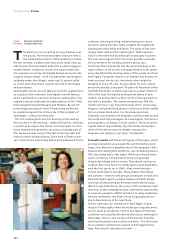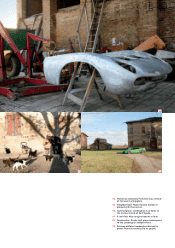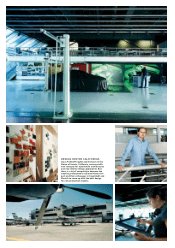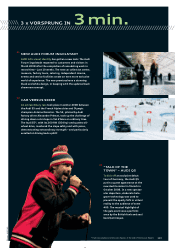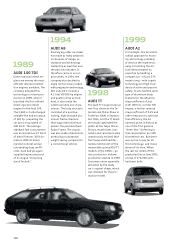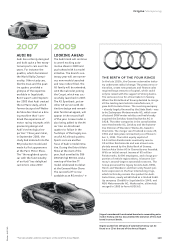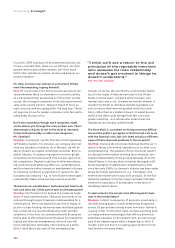Audi 2008 Annual Report Download - page 115
Download and view the complete annual report
Please find page 115 of the 2008 Audi annual report below. You can navigate through the pages in the report by either clicking on the pages listed below, or by using the keyword search tool below to find specific information within the annual report.
/
/
112
Vorsprung Imagination
and gearshift knobs or fabrics for trim
panels, some of the trendiest materi-
als now have a patina, or signs of use.
The worn denim look is also “in.” The
designers under Potthoff’s supervision
are even experimenting with innovative
high-tech materials that are able to
cleanse the ambient air in the interior.
Interior woods are also being treated
completely differently than they were
a few years ago: Thickly lacquered
wood is giving way to wood with a
natural look and feel. “Materials are
being treated less and less so that
their intrinsic character is shown to
its full advantage,” says Lapine.
Making such decisions requires exten-
sive lab work, for instance by exam-
ining materials for scuff resistance or
durability, which is later retested in
Ingolstadt. Here too, the L.A. studio
provides ideas for the first develop-
ment phase, delivering mood boards
with material samples. “That gives
our colleagues in Germany a perfect
feel for how tastes are trending in the
United States,” notes Lapine.
Also worth noting is an eco-design
study conducted in 2006: the Clear Car
project. The purpose of this transpar-
ent, virtual model was to demonstrate
“how the ‘Green Topic’ could be of-
fered in an appealingly sporty form,”
explains Potthoff. The CO2-free design
study, which is externally reminiscent
of classic coupes of the 1940s, was
based on an electric propulsion system
with fuel cells. The studio’s objective
was to present the first utterly appeal-
ing vehicle with wheel-hub motor,
proving that “an eco-friendly car doesn’t
mean having to sacrifice on some-
thing,” notes the Design Center chief.
“Believe me, our pencils are sharp-
ened. We do a lot of work in secret,
and of course we also have to evaluate
our ideas economically.” In view of the
profound challenges facing the auto
industry, it is easy to understand that
the designers in L.A. are itching to
get going.
the future look like? What are the
global trends? How are tastes devel-
oping among American car buyers?
Is it the same in Asia and the Pacific
area? What can be deduced for Europe
from these trends? What esthetic and
ergonomic factors are important for
the next-generation global Audi design?
L.A. is the perfect location to explore
these questions and to contemplate
new and unconventional vehicles.
“California has the most progressive
and experimental automobile culture
in the world,” says Claus Potthoff, the
studio’s Executive Design Director.
“What’s more, with its multicultural
society, the Sunshine State is a trail-
blazer in many fields, setting trends
that other regions will only adopt
much later.” Its proximity to Holly-
wood, for example, and the ability to
swap ideas with scriptwriters working
on futuristic scenarios stimulates car
designers’ imagination.
Whether it’s entertainment, technol-
ogy, art, sports or science, the melting
pot which is California is historically
more open to new things than many
other places on earth. And, for years,
that’s exactly what has attracted the
smartest, most creative and most in-
novative brains from around the world.
Of course, this is also reflected in the
Audi team, where Americans, Germans,
Italians and Koreans bring individual
facets of their own cultures and men-
talities with them to the drawing table.
“There’s an incredible amount of talent
here, and we are benefiting tremen-
dously from their ideas and sugges-
tions,” says Min, a native South Korean
who originally came to California to
study automotive design at the
renowned Art Center College of Design
in nearby Pasadena.
No doubt about it: Californians not
only love their cars, they live in them.
People interact differently with their
vehicles here. They tend to be more
mobile, spending more time on the
road – in part due to the fantastic
weather. “Automobiles aren’t just a
means of transportation in Califor-
nia,” says General Manager Hendrik
Veltmann. “A car is an expression of
one’s personality and so people want
to feel as comfortable in their cars
as they do at home.” To fully appreci-
ate the peculiarities of the important
U.S. market, you have to live here.
Judging by the ever-present air con-
ditioning systems and super-wide
highways, one would hardly suspect
at first glance that the Golden State
has made sustainability a high priority
for years. In addition to a health-
conscious lifestyle (“Green Living”),
with organic food available in any
supermarket, rigid water conservation
programs and strict energy conserva-
tion codes to regulate construction
have been in place since the 1990s.
“The subject of sustainability is ap-
proached much more emotionally and
less technically in the United States
than it is in Germany,” says Potthoff.
These factors also influence the de-
signers’ work.
And finally there are innumerable small
start-ups and initiatives with superb
ideas – especially in nearby Silicon Val-
ley. “There’s a lot we can learn from
them,” says Potthoff. This is of particu-
lar value to the Color & Trim Depart-
ment, which deals with the design of
colors, surfaces and materials. The
designers here are constantly on the
lookout for the materials and colors of
the future. “There is a marked trend
toward sustainably produced textiles,”
notes designer Sabine Lapine. “Recy-
cled materials are also continuing to
gain importance – for instance, using
yarn made of recycled water bottles for
interior textiles.” The entire esthetics
of the interior has fundamentally
changed. Whether it’s leather for seats
“The subject of sustainability is approached
much more emotionally and less technically
in the United States than it is in Germany.”
Claus Potthoff, Executive Design Director, Audi Design Center California
Titus Arnu works as a reporter for Süd-
deutsche Zeitung, among others. He lives in
Munich. Jochen Siegle reports from San Fran-
cisco about life on the U.S. West Coast for
Spiegel Online and die ZEIT, among others.




